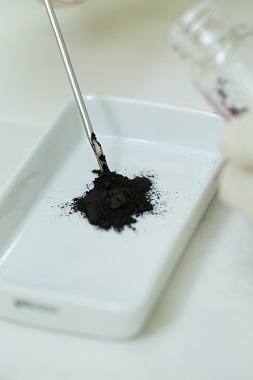Can we help you?
Contact us

Can we help you?
Contact us

Thank you for contacting us
Your form has been submitted successfully Our team will contact you again as soon as possible.
Whooppss...!! An error has occurred
Try sending later or write an email directly to areaempresas@ua.es

INFO
SHEET
DOWNLOAD
EXECUTIVE
ABSTRACT
CONTACT DETAILS: Research Results Transfer Office-OTRI
University of Alicante
Tel.: +34 96 590 99 59
Email: areaempresas@ua.es
http://innoua.ua.es
The technology developed by researchers at the University of Alicante optimizes the production of synthetic natural gas at low temperatures.
The technology consists of a catalyst that facilitates the conversion of green hydrogen into synthetic natural gas simultaneously depleting carbon dioxide emissions. This is a highly energy-demanding process, and the new catalyst presents technical advantages with respect to available catalysts. The main advantage is the reduction of the energy consumption, since it allows the reaction to be accelerated in a temperature range much lower (from 190 ºC on) than the working temperatures of usual catalysts (typically above 300 ºC).
This technology is very interesting for companies in the energy sector working on the production of synthetic natural gas, green hydrogen obtention and industries with high carbon dioxide emissions.

Current energy sources are classified into renewable energy sources and non-renewable energy sources, the latter mainly including fossil fuels (natural gas, oil and coal).
Renewable energy sources are more sustainable, since do not generate negative environmental impact, but they have the handicap of the discontinuous energy production.
Therefore, it is necessary to develop energy storage systems for the green energy excess produced in certain periods to be consumed during deficit periods, ensuring always enough energy supply.
One way to store the excess of green energy consists of using this excess to hydrolyze water and produce hydrogen (H2). Hydrogen produced using renewable energy is called Green Hydrogen, and this chemical way of energy storage is expected to become very relevant in the coming years.
The renewable energy stored as Green Hydrogen can be recovered and used when required by reaction with oxygen (O2), only producing water in a completely clean and waste-free process.
However, there are technical problems related with the storage of transportation of Hydrogen, since it is a flammable and light gas that cannot be liquefied at room temperature. High pressure storage and transportation is necessary, which is dangerous and, in some cases, unfeasible. In addition, currently there are not infrastructures for large-scale storage and transportation of hydrogen.
An alternative is to use this Green Hydrogen to produce synthetic natural gas, by hydrogenating CO2. The result is that the renewable energy is stored as methane (CH4), and methane can be easily stored and transported using the already existing infrastructure for conventional natural gas.
In this way, renewable energy can be converted into a compound that can be easily transported wherever it is required and energy is recovered in a clean and sustainable way.
The technology developed by the researchers consists of a new catalyst that facilitates this conversion of green hydrogen into synthetic natural gas.
One of the technological challenges in this field is to achieve the production of synthetic natural gas minimising the energy consumption, and new catalysts are required for this purpose.
Currently, there are different catalysts that facilitate this reaction. However, the technology developed by the University of Alicante consists of obtaining a new catalyst that facilitates this reaction and presents a series of notable technical advantages. The main advantage is that reduces the energy consumption required and allows the reaction to be accelerated in a temperature range (190ºC) much lower than the working temperatures of most currently available catalysts (around 300ºC).
This new catalyst consists of a mixture of cerium, nickel and ruthenium oxides and is generated through a proprietary procedure developed by the university. The catalyst is active and selective accelerating the hydrogenation of CO2 to CH4, being the most active and selective one identified to date for obtaining synthetic natural gas at low temperatures.

Figure 1. Material developed in the laboratory.
MAIN ADVANTAGES OF THE TECHNOLOGY
The main advantage of the catalyst is the production of synthetic natural gas in a more economical and sustainable way.
The new catalyst operates in a much lower temperature range than the other catalysts used in this process.
INNOVATIVE ASPECTS
Getting a catalyst of this type to operate in such a low temperature range is a complex technological challenge. It was necessary to select the most appropriate components, optimize their composition and develop a specific synthesis method that would allow the composition, morphology and surface structure to be controlled at a molecular level.
The result has been a much more efficient catalyst that considerably reduces the cost of generating synthetic natural gas.
The research group has optimized the catalyst and its manufacturing process to ensure that it operates at low temperatures. The catalyst has been implemented at pilot plant scale and the process is ready for industrial scale-up.
This technology is particularly interesting for the energy sector and, in particular, for companies that generate synthetic natural gas, produce green hydrogen and/or are intensive in the emission of carbon dioxide to the atmosphere.
Companies interested in acquiring this technology for commercial exploitation or participate in a joint venture together with a start-up of the University of Alicante throughout:
• Licensing agreements.
• Cooperation agreements
• R+D project agreement to undertake technology-related projects (to adapt the technology to particular scenarios).
This technology is protected by patent application.
• Title of the patent: " Catalizador para producir gas natural sintético a baja temperatura ".
• Application number: P202430446
• Application date: May 31, 2024
Materials and Nanotechnology
Chemical Technology

Carretera San Vicente del Raspeig s/n - 03690 San Vicente del Raspeig - Alicante
Tel.: (+34) 965 90 9959




